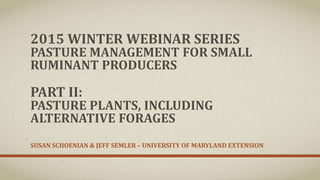The document outlines a winter webinar series focused on pasture management for small ruminant producers, particularly emphasizing different pasture plants and alternative forages. It covers a range of topics including planning pasture systems, various types of grasses, legumes, and forbs, as well as their management and nutritional aspects. Instructors from the University of Maryland Extension provide insights on effective rotational grazing systems and suitable forage types for diverse agricultural conditions.







































